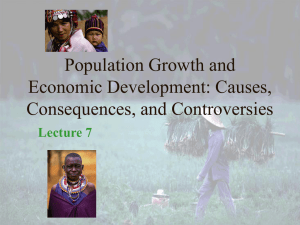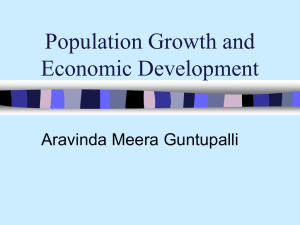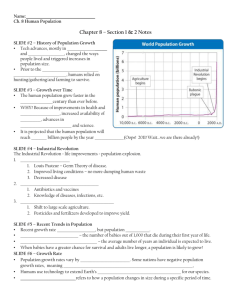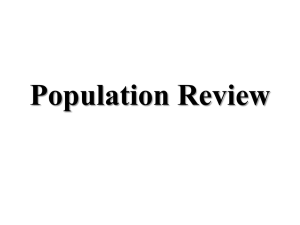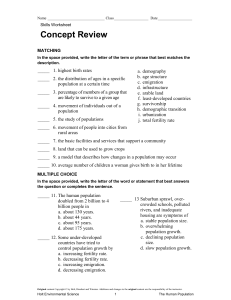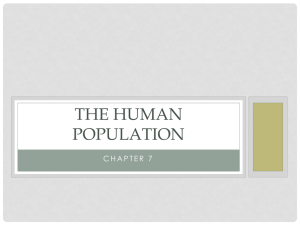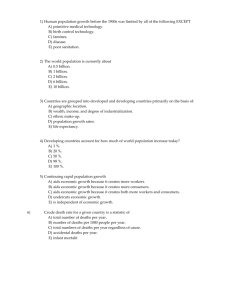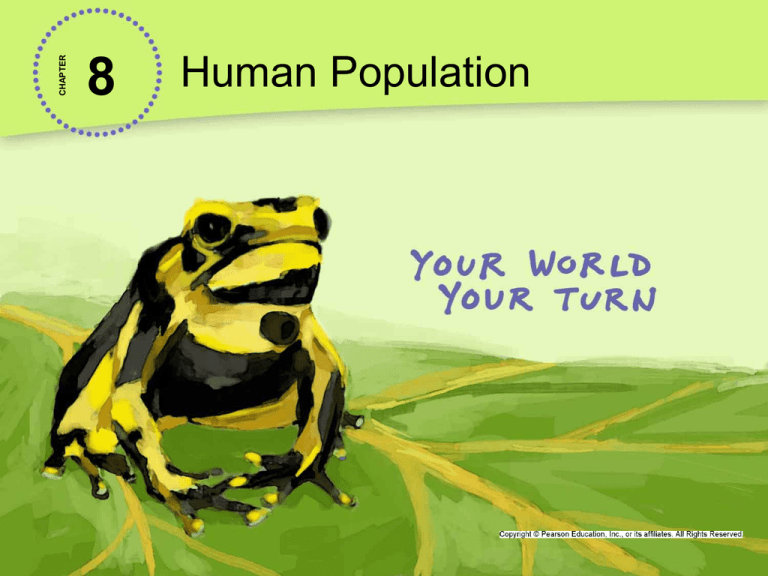
CHAPTER
8
Human Population
China’s One-Child Policy
• In 1970, the average Chinese woman had about six
children.
• Since 1979, China has used a system of rewards and
punishments to enforce a one-child limit to slow
population growth.
• In 2005, there were 32 million more males than
females in China under the age of 20.
Talk About It Is it ethical for governments to limit or
encourage human population growth?
Lesson 8.1 Trends in Human Population Growth
As of 2010, the human population
is 6.8 billion (and counting).
Lesson 8.1 Trends in Human Population Growth
History of Human Population
Growth
• Advances in agriculture
and industry have led to
longer lifespans and
remarkable population
growth.
• Agriculture: Helped people
meet their nutritional needs;
increased free time to
pursue crafts and trading
• Industry: Improved
sanitation, medicine, and
food production
Did You Know? Basic sanitation was rare even in the medical
profession until 1861, when Dr. Ignaz Semmelweis discovered
that doctors’ hand washing greatly reduced patient mortality.
Lesson 8.1 Trends in Human Population Growth
Infant Mortality and Life
Expectancy
• Populations are likely to grow
when infant mortality is low and
life expectancy is high.
• Infant mortality: Number of babies
out of 1000 that die during their first
year of life
• Life expectancy: Average number
of years a person is expected to live
• Population growth rate describes
the change in population’s size
during a given period of time.
Lesson 8.1 Trends in Human Population Growth
Recent Trends in Human
Population Growth
• Growth rate of human
population has slowed from
2.1% to about 1.2% since
the 1960s.
• Population growth rates vary
by region. Some nations have
negative population growth
rates, meaning the population
is getting smaller.
• Humans use technology to
extend Earth’s carrying
capacity for our species.
Did You Know? To estimate how long
it would take any population to double,
divide 70 by its growth rate.
Lesson 8.1 Trends in Human Population Growth
Demography: Describing the
Human Population
• Population size:
Number of people
• Population density:
Number of people living
per mi2 (or per km2)
• Population
distribution: How
people are distributed
within an area
Lesson 8.2 Predicting Population Growth
Some scientists predict
that there will be
9 billion people on
Earth by 2050, while
others maintain that the
population will be
closer to 10.5 billion.
Lesson 8.2 Predicting Population Growth
Fertility Rate
• Total fertility rate: Average
number of children a female
has during her life
• Replacement fertility rate:
The total fertility rate for a
nation that would keep its
population stable
• For most nations, a
replacement fertility rate of
2.1% would keep population
size stable. A greater rate
would increase population size;
a lesser rate would decrease it.
Lesson 8.2 Predicting Population Growth
Age Structure
• Age structure describes the
relative number of people
within different age brackets
in a population.
• A population of mostly young
people tends to grow. A
population of mostly old
people tends to shrink.
• A population with equal
numbers of young and old
tends to remain stable in size.
Lesson 8.2 Predicting Population Growth
Sex Ratio
• Describes the relative numbers of females and males
• Typical sex ratio for humans is 1.00 females : 1.06 males.
For every
100 females
born, 106 males
are born.
• Human activity
such as migration
can skew sex
ratios.
Lesson 8.2 Predicting Population Growth
The Demographic Transition
• Model that explains a population’s change from high
birthrates and death rates to low birthrates and death rates
•
•
•
•
Pre-industrial stage: Birthrates and death rates are high.
Transitional stage: Birthrates are high but death rates are declining.
Industrial stage: Birthrates start to decline; death rates stay low.
Post-industrial stage: Both birthrates and death rates fall to low and
stable levels.
• Demographic transitions are
the result of economic
growth and social changes.
Did You Know? Over the past 50 years,
worldwide average life expectancy has
increased from 46 to 68 years.
Lesson 8.2 Predicting Population Growth
Social Factors and Population
Growth
• Developing nations:
• Higher fertility, infant
mortality, and death rates
• Lower life expectancy
• Low per capita resource use
• Developed nations:
• Lower fertility, infant mortality,
and death rates
• Higher life expectancy
• High per capita resource use
Did You Know? On average, 1 American
consumes as much natural resources as
5 Chinese or 13 Pakistanis.
Lesson 8.3 People and Their Environments
Globally, the average ecological
footprint is 2.3 hectares. The
average American has an ecological
footprint of 9.0 hectares.
Lesson 8.3 People and Their Environments
Environmental Impacts
• The environmental impact of humans depends on the
way they live.
• Poorer societies tend to have smaller ecological
footprints than affluent societies, but still strain the
environment:
• Overwhelmed governments can’t supply clean water or
adequate sewage treatment.
• Poverty often leads to land overuse.
• Deforestation, flooding, disease, and habitat loss can become
common, as land is cleared for farming.
Lesson 8.3 People and Their Environments
The Wealth Gap
• Currently, the richest 20% of
the world’s people use 86%
of its resources.
• As developing nations such
as China continue to
develop, new environmental
problems will emerge, as the
need for and use of
resources increases.
• Resource availability affects
quality of life.
Did You Know? Globally, 1.4 billion people
live on less than $1.25 per day, and another
2.6 billion live on less than $2 per day.
Burning of fossil fuels creates a haze of
pollution over the eastern coast of China.
Lesson 8.3 People and Their Environments
Impacts of Technology
• Negative impacts:
• Has enabled resource exploitation
• Has resulted in pollution, biodiversity
loss, and climate changes
• Positive impacts:
• Enables longer, healthier, more
comfortable lives
• Technologies such as recycling can
help reduce environmental impact.
• Renewable energy technology can
produce cheap, clean energy.
Solar water pump



